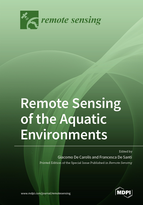Remote Sensing of the Aquatic Environments
A special issue of Remote Sensing (ISSN 2072-4292). This special issue belongs to the section "Environmental Remote Sensing".
Deadline for manuscript submissions: closed (1 May 2021) | Viewed by 58041
Special Issue Editors
Interests: SAR; optical imagery; ocean winds; waves; sea ice; internal waters; water quality
Special Issues, Collections and Topics in MDPI journals
Interests: ocean waves; winds; sea ice; wave propagation
Special Issues, Collections and Topics in MDPI journals
Special Issue Information
Dear Colleagues,
Observation of the aquatic environments represented by inland surface water, seas and oceans has been traditionally linked to the need of safe navigation and fishery. More recently, there is a growing demand on monitoring capability due to the increasing concerns of contaminants produced by anthropogenic activities on the quality of inland and coastal waters.
Remote observations allow to gather plenty information about ocean bathymetry, ocean waves, sea surface temperature, surface winds, ocean color, coral reefs, sea and lake ice, oil pollutants, suspended solid concentrations, algal blooms, floating plastic waste in marine waters, and other bio-geophysical parameters related to the aquatic environment.
In this context, active and passive remote sensors offer suitable solutions for a synoptic monitoring of the water surface along with all the properties directly involved. The perspective is to develop methods and applications to extract detailed environmental information from multi-sensor observations.
This Special Issue on “Remote Sensing of the Aquatic Environments” is focused on all the aspects related to the remote measurement of the bio-geophysical properties of the water bodies and the methodologies aimed at studying the relevant processes. The topics of this Special Issue will include, without being limited to, the following subjects:
- Remote sensing of wind, waves, salinity, precipitation.
- Remote sensing methods for the detection of floating materials and determination of related bio-geophysical properties (such as type, extent, volume) with special focus on sea ice, lake ice, algal blooms, spilled oil.
- Remote sensing of shorelines, bathymetry, upwelling phenomena.
- PolSAR and InSAR methods for ocean waves and sea state measurement.
- Remote sensing of the ocean and inland waters color.
- Remote sensing concepts and advanced sensors for the aquatic environment.
Dr. Francesca De Santi
Guest Editor
Manuscript Submission Information
Manuscripts should be submitted online at www.mdpi.com by registering and logging in to this website. Once you are registered, click here to go to the submission form. Manuscripts can be submitted until the deadline. All submissions that pass pre-check are peer-reviewed. Accepted papers will be published continuously in the journal (as soon as accepted) and will be listed together on the special issue website. Research articles, review articles as well as short communications are invited. For planned papers, a title and short abstract (about 100 words) can be sent to the Editorial Office for announcement on this website.
Submitted manuscripts should not have been published previously, nor be under consideration for publication elsewhere (except conference proceedings papers). All manuscripts are thoroughly refereed through a single-blind peer-review process. A guide for authors and other relevant information for submission of manuscripts is available on the Instructions for Authors page. Remote Sensing is an international peer-reviewed open access semimonthly journal published by MDPI.
Please visit the Instructions for Authors page before submitting a manuscript. The Article Processing Charge (APC) for publication in this open access journal is 2700 CHF (Swiss Francs). Submitted papers should be well formatted and use good English. Authors may use MDPI's English editing service prior to publication or during author revisions.
Keywords
- Ocean winds, wave, currents, bathimetry
- Water quality
- Oil spill, algal blooms
- Sea ice
- Coastline, inland waters
- Sar, optical data







